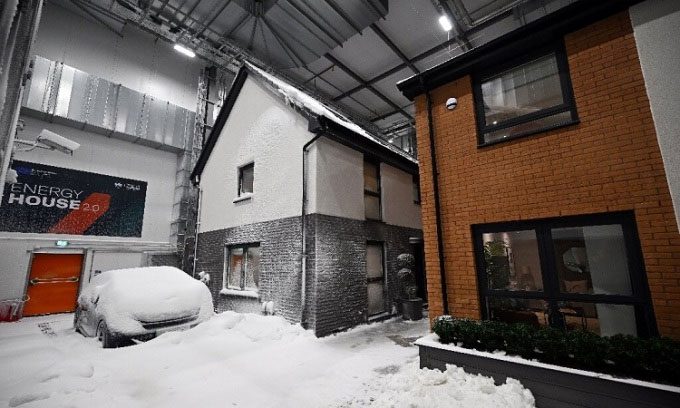The Energy House 2.0 laboratory can test nearly all types of weather, including snowstorms, heavy rain, and strong winds, to assess the performance of energy consumption products and their sustainability features.
The thermometer reads below 0 degrees Celsius as a heavy snowfall blankets two newly constructed homes inside the expansive laboratory in northern England. Despite the freezing conditions, the energy-efficient homes remain warm thanks to advanced heating technologies and insulation. This is part of the Energy House 2.0 scientific experiment worth $19.2 million, designed to help builders around the world reduce carbon emissions, save energy, and combat climate change, as reported by Phys.org on February 5th.

Two houses in the Energy House 2.0 laboratory. (Photo: AFP).
The project is located in a massive warehouse simulation laboratory at the University of Salford near Manchester city center, which opened last month. Rain, wind, sunlight, and snow can be recreated at temperatures ranging from -20 to -40 degrees Celsius, operated from a control center. “What we are trying to achieve here is to simulate weather conditions that approximately 95% of the global population will experience,” said Professor Will Swan, head of the energy house laboratory at the university.
The facility includes two chambers that can experience different weather conditions simultaneously, testing housing types from around the world to explore how to provide energy-efficient and zero-emission homes. The two English-style houses, built by British companies, will remain in place for several years. Other contractors may then rent space in the laboratory to construct their own projects.
The first house in the project was built by the real estate company Barratt Developments in the UK and the materials company Saint-Gobain in France. The structure features decorative brick cladding on a wooden frame and insulation, with solar panels on the roof.
Scientists are testing the efficiency of various heating systems, including air-source heat pumps. In the living room, hot water pipes run along the base of the walls. Simultaneously, heating is also provided through infrared technology embedded in the plywood and wall panels. Mirrors also serve as infrared emitters while multiple sensors monitor which rooms are in use.
Residents can manage the technology through a control system similar to Amazon’s voice-activated Alexa interface. Contractors estimate that this advanced technology will reduce energy costs to just one-fourth of what the average household in the UK currently pays. This will be a significant contribution to the UK’s goal of achieving net-zero emissions by 2050 in the fight against climate change.
With the new super laboratory, scientists and companies will no longer need to rely on external weather conditions. They can test all weather conditions in a year within a single week. The ultimate goal of the project is to create a comfortable, cost-effective, and commercially viable environment while addressing sustainability issues in construction.
















































